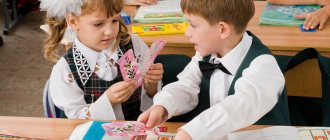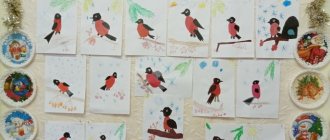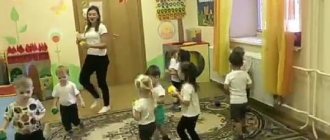Summary of a lesson in the preparatory group on preparing the hand for writing “Fun Competitions”
Goal: Development of attention, speed, reaction, motor dexterity, preparation of the hand for writing, development of accuracy of hand movements.
Materials: handouts (for each child): notebooks, a set of simple and colored pencils, chips of different colors, lacing, samples of graphic exercises “Geometric pattern”, “Rectangles”, “Superman”; medals for 1st, 2nd and 3rd place.
Progress of the lesson
Educator. - Children, today we will have a fun competition. For each correctly completed task, the child will receive a chip. At the end of the class we will tally your chips and award 1st, 2nd and 3rd place winners. Remember the main thing is that the task is completed correctly and accurately, and not quickly!
- But first, just as athletes warm up before real competitions, you and I will do a warm-up.
Dynamic pause
Warm-up begins We stood up, straightened our backs, leaned to the right - to the left And repeated again (bending to the sides) We squat in a count of One, two, three, four, five. This necessary work is to train the leg muscles (squats). And now we perform arm jerks together with you (arm jerks in front of the chest).
1st task “Geometric pattern” (children are given samples)
- Why do you think it is called that? (consists of geometric shapes).
For correctly completing the task, the child is given 1 chip.
2nd task “Rectangles”
- Be careful, each rectangle has its own pattern, you need to repeat it correctly.
For correctly completing the task, the child is given 1 chip.
3rd task Graphic dictation
- I will dictate half of the drawing, you must guess what it is and draw the second half.
(chips are distributed)
4th Lacing task “Repeat the pattern”
- You need to tie your own shoelaces, just like
shown in sample (sample showing)
For completing the task correctly, the child is given 1 chip.
5th task "Superman"
— Guys, you spent the whole year studying at the Obedient Pencil school. I believe that by the end of the year you have become real supermen. And I suggest you portray such a superman (showing a sample)
For completing the task correctly, the child is given 1 chip.
Result: Chips are counted and medals are distributed.
What is important for preparation
In order to facilitate the process of developing writing skills, reduce stress and not cause a negative attitude towards school, it is necessary to train the hand from the age of three.
General physical development
Good physical fitness plays an important role in the formation of beautiful handwriting. Strengthening the muscular system promotes endurance and allows you to sit at your desk during the lesson. Strong back muscles prevent curvature of the spine and maintain correct posture. Developed muscles of the shoulder girdle and arms relieve rapid fatigue, trembling and muscle spasms.
The child develops physically during active games on the street, riding a bicycle or scooter, jumping on a trampoline or inflatable slide, etc.
Motor skills
These are coordinated movements aimed at performing some action.
Motor skills are divided into:
- large – this is coordination of movements, maintaining balance, awareness of the position of the body in space: walking, running, standing up, sitting down, lying down, turning;
- fine - precise movements of the fingers.
To develop writing skills, it is equally important to pay attention to the development of both types of motor skills. When writing, the small muscles of the hand and the large muscles of the body are used to keep the body in a straight position.
Orientation in space
It will be easy for a child to navigate in a notebook or on a piece of paper if he knows such concepts as right-left, top-bottom, side, center, corner. To do this, when talking with your baby while dressing and undressing, walking, bathing, feeding, pay his attention to what the right and left arms or legs are doing. Ask what is seen ahead and what is left behind.
Graphic skills
In the process of drawing, the muscles of the hand are trained. Hatching, coloring, and drawing in cells develops the skill of observing boundaries, writing hygiene, and the ability to navigate in space.
"Skillful Hands"
An integrated approach to developing skills, which includes various kinds of crafts, appliqués, modeling, design, knitting and embroidery. Fine motor skills, spatial orientation, perseverance, concentration, and accuracy are improved.
Summary of a lesson on preparing the hand for writing for preschoolers in the Snezhinka kindergarten
Goal: Development of attention, speed, reaction, motor dexterity, preparation of the hand for writing, development of accuracy of hand movements.
Material: illustrations with snowflake; handouts (for each child): notebooks, a set of simple pencils, spiky balls; pouch.
Progress of the lesson
Educator: Hello, guys! Look what I brought for you today (showing a picture with parts from a snowflake). Do you understand what this is? Yes, I think the same thing, that this is a snowflake, only unusual. Do you know why she is like this? The evil north wind broke our snowflake. And he said that we can return her only when we complete all his tasks. Let's help our snowflakes become beautiful again and shine for our joy? (Yes)
1st task
Then the 1st task. In order for the first ray of a snowflake to return to its place, you need to do a winter warm-up: (Children imitate walking in the snow, shoveling snow, making a snowman and playing with snowballs)
Educator: Guys, after completing the task, we will put one ray of a snowflake into this magic bag, which will then help us return our snowflake (we put the first ray of a snowflake in the bag).
2nd task. “Repeat the pattern!”
2. From sticks
.
Educator: Well done! Another ray saved from the evil north wind (put it in a bag).
3rd task. “Continue the drawing” (after completing the drawing, children are asked to independently complete the details (eyes, smile...))
Educator: Guys, I propose to draw a good wizard who will help us tame the north wind so that it doesn’t break anything else.
Educator: Well done, everyone did the task well! I hope the good wizard can help us. We place another ray of snowflakes in our magic bag.
4th task. “We’ll play with the snowball” (spiky ball)
- We will play with the snow and warm our palms. (Children roll the ball between their palms in different directions, squeeze the ball in their hands, throw it and catch it with both hands, then alternately with each hand)
Educator: Well done! The 4th ray is saved from the evil north wind (put it in a bag).
5th task. "Hatching"
Educator: Well done! The 5th ray is saved (put it in a bag). Last task left.
Educator: We have 1 ray left. To disenchant him, you must complete the most difficult task.
Formation of writing skills in children
Writing is one of the ways of speaking. The process of developing a skill is long and complex. It starts at the age of two or three and continues until the age of seven, when children enter first grade. Many parents start preparing their children for school in advance. They buy notebooks with copybooks of letters, and do not understand why many days of hard training do not produce results.
It is important to know the difference between preparing to write and learning to write. In preschool age, full-fledged writing is impossible due to age-related characteristics of the structure of the nervous system. At this stage, the emphasis is on general physical development and strengthening the muscles of the hand, on developing perseverance, coordination of body movements, concentration, and visual orientation.
Writing skills are developed in three stages:
- analytical - thinking about each movement and analyzing it, for example, how it is more convenient to take the handle, with what force to press, etc.
- synthetic – combining elements into a holistic process, conscious thinking about each step, visual control of each action;
- automation means that the skill has been formed: the child, without thinking, completes written tasks, hand movements are smooth, effortless.
In preschool age, the child gains graphic experience, learns to use written objects and observe hygiene rules. The child acquires the skills to correctly tilt a notebook, write individual letters and words of the required size and at the required angle, and correct body position while writing.
Exercises
Regular exercises will help strengthen your hand muscles and add confidence in writing:
- "Blooming Flower"
The hands are clenched into fists and connected together. The thumbs are straight, touching the lateral surfaces. Then the fingers are straightened, the palms are slightly moved away from each other, the wrists are connected. Reminds me of an unopened bud. The flower begins to open - without separating the wrists, the hands are moved to the sides, the fingers are spread out.
- "Duckling fingers."
The palm is open, fingers spread. The index finger is curled into a hole at the base of the thumb. The pads of the first finger alternately touch the middle, ring and little fingers, like the beak of a duck.
- "Tight hugs."
The fingers of both hands are spread out, pressing the tips against each other with force for 5 seconds. Then they cross into a lock, pressing their palms tightly. Count to 5. After the exercise, shake your hands to relax the muscles.
- "Chair".
Place your palms together, fingers together, looking up. The right hand slides downwards along the left. When your fingertips reach the top of your left palm, you need to stop. By pressing at the base of the fingers of the left hand, the hand bends at the wrist joint. In this case, the fingers remain in a vertical position. The curved palm resembles a chair with a backrest.
- "Welcome handshake."
The index, middle and ring fingers of the right hand are pressed against the palm. Each finger of the left hand is greeted with the thumb and little finger, as if shaking with both hands during a greeting.
How to teach a child to hold a pen correctly
It is important that the child learns how to properly hold a pen and pencil before entering school. Correcting mistakes and retraining the grip is difficult. Incorrect position of the fingers, tilt of the pen and rotation of the hand make handwriting uneven and illegible, cause rapid hand fatigue, and affect posture.
What a correct grip looks like:
- the handle lies between the thumb and middle finger, pressed on top with the index finger;
- the distance to the writing rod is about two centimeters;
- a straight line can be roughly drawn through the hand, wrist and elbow joints;
- the top of the pen or pencil points to the child's shoulder.
The most common mistakes
Preschool children, when they begin to master working with stationery items, make the following mistakes:
- The child holds a pencil or felt-tip pen with his whole hand, clenching it into a fist.
- In a three-finger grip, the thumb is bent and directed perpendicular to the index finger to its middle phalanx.
- The pen rests on the ring finger and is held by the middle, index and thumb.
- The brush bends inward, with the top edge of the object pointing away from you.
- The child holds the handle with all fingers (like a pinch).
- The fingers are located near the stylus, or far away so that the hand hangs over the table.
- When moving, it presses on the paper too much, leaving tears, or too lightly.
Methods to avoid mistakes
The following methods will help you avoid mistakes in learning to retain written objects:
- It will be easier to grip a pencil correctly if you hold a small piece of paper with your ring and little fingers.
- Draw a dot on the middle finger that will indicate the location of the pen.
- The finger game “building a house” will focus on three-finger holding: the handle is held between the middle and thumb; the index finger rises freely and can hit the handle like a hammer.
- Be sure to focus on the direction of the top of the pencil towards the child’s shoulder.
- To generate moderate pressure, use soft pencils or felt-tip pens.
- For optimal removal of fingers from the lead, mark a line on the writing object where to hold it.








